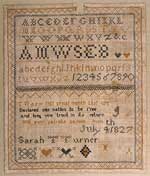From the collection of:
The Kentucky Historical Society || VAM Home
Sarah Turner (1811-1853)
NEEDLEWORK SAMPLER, 1827
Linen; 12.125" X 10.25"
Donated by Oeta A. Lynn, 1950.37
Courtesy Kentucky Historical Society
The first American sampler may have been worked as early as the 1650s, shortly after colonists settled this continent. American samplers from the 17th, 18th, and early 19th centuries were worked at home or in school by girls and young women mastering the art of needlework. As “samples” of a young girl’s (or, far less frequently, a young boy’s) skills, they served as references for future use of the motifs, patterns, and decorative stitches they contained. Children’s first samplers were usually very simple, with only alphabets, numbers, name, date, and sometimes a small amount of decorative stitching. As the student became more capable, samplers became more complex. More elaborate pieces included floral and landscape scenes and usually were made in exclusive private schools. Sarah Turner’s sampler includes a patriotic verse that embodies American sentiments of the early 19th century.
About the Artist
Sarah Thomas Turner was born in Tennessee on October 11, 1811 and died in Simpson County, Kentucky in February 1853. She married Stanly S. Wilkerson and died shortly after giving birth to her tenth child. Sarah is buried in the Turner family cemetery in Simpson County. The donor of this sampler said that it was woven by Sarah and Sarah’s mother, Elizabeth Martin Turner. Sarah’s father, Martin Turner, was a Baptist preacher who moved the family from Sumner County, Tennessee to Kentucky in 1809.
Classroom Ideas
Discussion: Why would needlework skills have been considered important by 19th-century Kentuckians? What purposes did needlework skills serve? Why do people do needlework today?
Activity: In the 18th and 19th centuries, girls made even stitches by counting threads. Today needleworkers can purchase kits with pre-printed designs. Try your hand at counting threads by working with yarn on burlap or perforated plastic. To print a pattern on finer cloth, draw X’s on graph paper, then transfer the design to the cloth using carbon or fabric transfer paper.
Links
Find out more about sampler making and the lives of children in Victorian times at the University of Exeter’s Virtual Victorians site.
[tofino.ex.ac.uk/virvic/themes/childhood/mapsamplerobj.htm]
Read about samplers and see numerous images of early American samplers at the Allison-Antrim Museum.
[www.greencastlemuseum.org/Special_Exhibits/samplers.htm]
Victoriana.com has a collection of embroidered samplers worked by one young girl between 1879 and 1882.
[www.victoriana.com/archive/jacobs.html]

